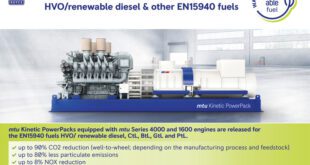CNBC is premiering a new show next week that takes a long look at the business of garbage in America. They have previewed parts of it and there is some good info about turning garbage into energy and using to offset other forms of energy for industrial production.
This is a growing area of alternative energy, converting waster into gas and then into power via generators. IN Oakland CA the regional sewage treatment plant implemented a program to collect table scraps from restaurants in the area. They send trucks around to collect waste food. Then the material is put into a digester and converted to methane gas which is fed into three large generators for power generation. They are able to power the entire energy needs of the sewage treatment plant from table scraps. They hope to roll out to plants across the country in the next few years.
This is critical stuff. Reducing waste, converting waste, and creating new energy from waste. Check out the preview of the CNBC show below.
Press Release from CNBC:
CNBC PRESENTS “TRASH INC: THE SECRET LIFE OF GARBAGE”
CNBC ORIGINAL TAKES VIEWERS INSIDE THE $52 BILLION DOLLAR BUSINESS OF GARBAGE
One-Hour Documentary Reported by CNBC’s Carl Quintanilla to Premiere on CNBC on Wednesday, September 29th at 9PM ET/PT
ENGLEWOOD CLIFFS, N.J., September 17, 2010—Across the world, we’re producing more of it than ever before, with no end in sight. In the U.S. alone we make 250 million tons of it a year. Garbage: we create it, we throw it away and we never think about it again — but from collection and disposal, to recycling and repurposing, it is a booming business raking in an estimated $52 billion dollars a year.
On Wednesday, September 29th at 9PM ET/PT, CNBC presents “Trash Inc: The Secret Life of Garbage,” a CNBC Original reported by Carl Quintanilla that takes an inside look at what happens to our garbage after we throw it out – where it goes, who touches it, and who makes money. Beyond the bags piled at the curb, viewers will see the intricate logistical ballet performed every day by armies of sanitation workers, engineers, and even entrepreneurs, to get rid of – and sometimes get rich from – our trash. They will also get a stunning and surprising look, once we throw something away, at where “away” can be – just part of the exploding worldwide environmental challenge posed by garbage.
It happens everyday, in every city and town across America. Sanitation workers come to collect our trash, but few of us think about where the garbage actually goes when we throw it away. Quintanilla follows the garbage that comes from the streets of New York City—home to the world’s largest sanitation department that collects nearly 12,000 tons of garbage and 2,000 tons of recyclables daily. It’s an epic odyssey, from curbside to multi-billion dollar transfer stations, where it is then sent by train and truck to remote locations from South Carolina to Pennsylvania.
In America, more than half of the country’s garbage ends up in landfills, which defy the common image of gaping garbage-filled holes in the ground. Modern landfills are sophisticated, environmentally regulated and expensive trash management systems. Every ton of trash brings a windfall for landfill owners and operators, as well as the towns that agree to have them within their borders. CNBC crews literally walk on a growing mountain of trash located just a short drive from the glitz of Las Vegas — the Apex Landfill, the largest in the U.S., owned and operated by Republic Services, the industry’s number two player. CNBC also visits Fox Township, PA, a working class town of 4,000 that makes half its yearly operating budget by taking in garbage, despite the concerns of many of its residents.
China, the second largest economy in the world, is in the midst of an unprecedented financial boom. It’s growing explosively in size, consumerism, profits — and garbage. It is the dirty downside to the Chinese economic miracle; today China is producing more refuse than any country in the world, and far more than it can properly dispose of. CNBC travels to Beijing, the heart of modern China, where in addition to upscale malls and Ferrari showrooms, there are hundreds of illegal dumps. Viewers will see the crisis first-hand: garbage in the streets, garbage in the water, garbage almost everywhere — and, no one solution to make it go away.
Trash probably isn’t the first thing that comes to mind when you think of Hawaii, but it’s there on Kamilo Beach, located on the remote southern coast of Hawaii’s Big Island. Tiny bits of garbage, mostly plastic, assault the shore, transforming a paradise into a wasteland. CNBC speaks with Charles Moore, a wealthy former businessman and trained chemist who has become one of the world’s leading authorities on one of the planet’s biggest threats: garbage in our seas. Moore takes CNBC to what’s known as “The Plastic Beach” – the washed up debris from a vast floating wasteland of trash now known as “the great Pacific garbage patch.”
CNBC also looks at how garbage has found a “second life.” Trash is reborn as a source of energy, a high-priced commodity and even raw material that is turned into clothing and carpets, taking trash out of the waste stream and into the revenue stream. Quintanilla speaks with Waste Management CEO David Steiner, who describes how his company has expanded its energy portfolio over the last 10 years in an effort to produce power and profits at every turn.
“Trash Inc: The Secret Life of Garbage” will re-air on Wednesday, September 29th at 10PM ET/PT and Sunday, October 3rd at 10PM ET.
 Alternative Energy HQ solar power for homes, wind energy, and bio fuel issues
Alternative Energy HQ solar power for homes, wind energy, and bio fuel issues






